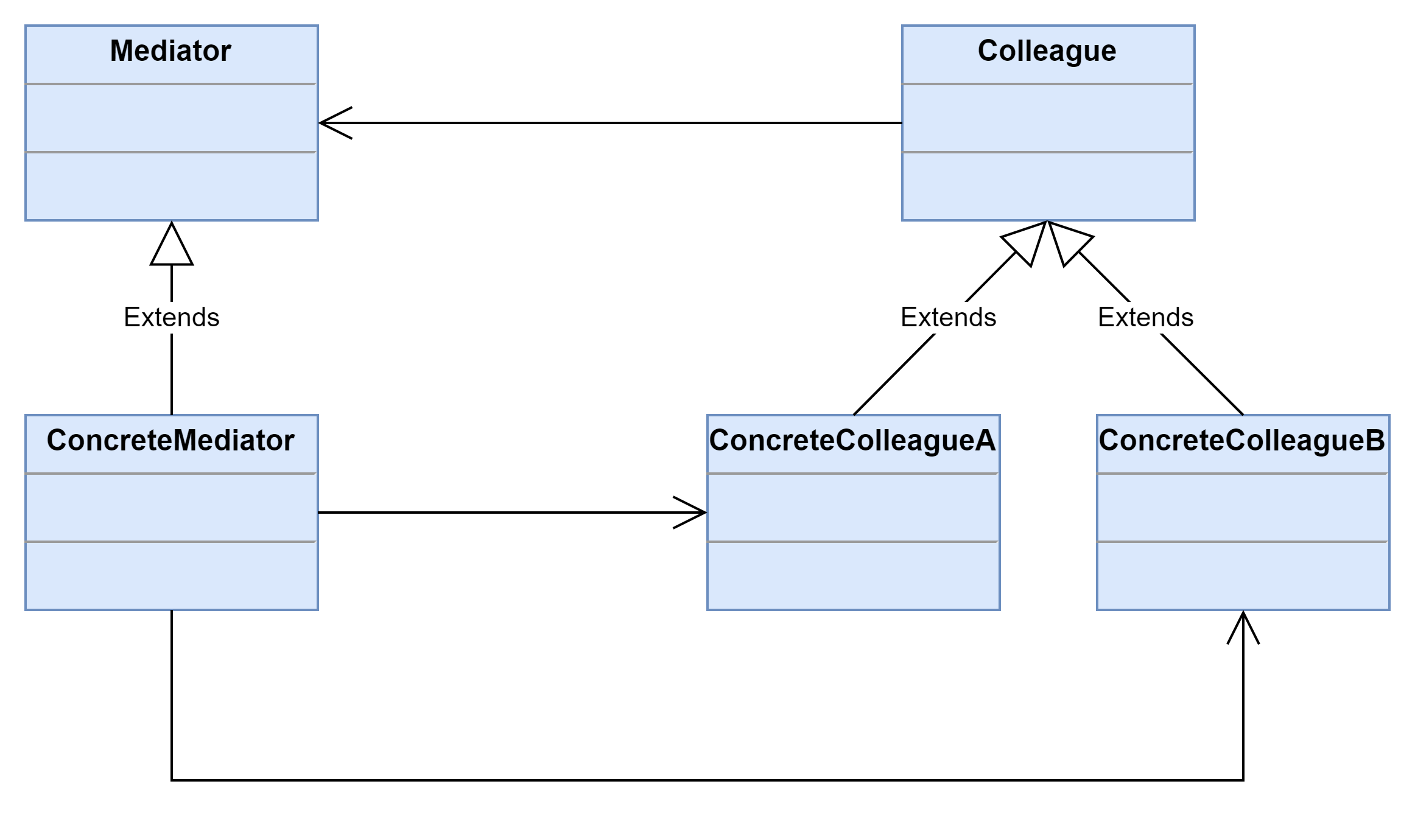中介者模式 (Mediator Pattern) - 协调多个对象之间的交互
用一个中介对象(中介者)来封装一系列的对象交互,中介者使各对象不需要显式地相互引用,从而使其耦合松散,而且可以独立地改变它们之间的交互。中介者模式又称为调停者模式,它是一种对象行为型模式。
结构图
- Mediator(抽象中介者):它定义一个接口,该接口用于与各同事对象之间进行通信。
- ConcreteMediator(具体中介者):它是抽象中介者的子类,通过协调各个同事对象来实现协作行为,它维持了对各个同事对象的引用。
- Colleague(抽象同事类):它定义各个同事类公有的方法,并声明了一些抽象方法来供子类实现,同时它维持了一个对抽象中介者类的引用,其子类可以通过该引用来与中介者通信。
- ConcreteColleague(具体同事类):它是抽象同事类的子类;每一个同事对象在需要和其他同事对象通信时,先与中介者通信,通过中介者来间接完成与其他同事类的通信;在具体同事类中实现了在抽象同事类中声明的抽象方法。
示例
using System;
namespace DesignPatterns.Mediator
{
// The Mediator interface declares a method used by components to notify the
// mediator about various events. The Mediator may react to these events and
// pass the execution to other components.
public interface IMediator
{
void Notify(object sender, string ev);
}
// Concrete Mediators implement cooperative behavior by coordinating several
// components.
class ConcreteMediator : IMediator
{
private Component1 _component1;
private Component2 _component2;
public ConcreteMediator(Component1 component1, Component2 component2)
{
this._component1 = component1;
this._component1.SetMediator(this);
this._component2 = component2;
this._component2.SetMediator(this);
}
public void Notify(object sender, string ev)
{
if (ev == "A")
{
Console.WriteLine("Mediator reacts on A and triggers following operations:");
this._component2.DoC();
}
if (ev == "D")
{
Console.WriteLine("Mediator reacts on D and triggers following operations:");
this._component1.DoB();
this._component2.DoC();
}
}
}
// The Base Component provides the basic functionality of storing a
// mediator's instance inside component objects.
class BaseComponent
{
protected IMediator _mediator;
public BaseComponent(IMediator mediator = null)
{
this._mediator = mediator;
}
public void SetMediator(IMediator mediator)
{
this._mediator = mediator;
}
}
// Concrete Components implement various functionality. They don't depend on
// other components. They also don't depend on any concrete mediator
// classes.
class Component1 : BaseComponent
{
public void DoA()
{
Console.WriteLine("Component 1 does A.");
this._mediator.Notify(this, "A");
}
public void DoB()
{
Console.WriteLine("Component 1 does B.");
this._mediator.Notify(this, "B");
}
}
class Component2 : BaseComponent
{
public void DoC()
{
Console.WriteLine("Component 2 does C.");
this._mediator.Notify(this, "C");
}
public void DoD()
{
Console.WriteLine("Component 2 does D.");
this._mediator.Notify(this, "D");
}
}
class Program
{
static void Main(string[] args)
{
// The client code.
Component1 component1 = new Component1();
Component2 component2 = new Component2();
new ConcreteMediator(component1, component2);
Console.WriteLine("Client triggers operation A.");
component1.DoA();
Console.WriteLine();
Console.WriteLine("Client triggers operation D.");
component2.DoD();
}
}
}运行结果
1
2
3
4
5
6
7
8
9
10
Client triggers operation A.
Component 1 does A.
Mediator reacts on A and triggers following operations:
Component 2 does C.
Client triggers operation D.
Component 2 does D.
Mediator reacts on D and triggers following operations:
Component 1 does B.
Component 2 does C.
总结
中介者模式将一个网状的系统结构变成一个以中介者对象为中心的星形结构,在这个星型结构中,使用中介者对象与其他对象的一对多关系来取代原有对象之间的多对多关系。中介者模式在事件驱动类软件中应用较为广泛,特别是基于GUI(Graphical User Interface,图形用户界面)的应用软件,此外,在类与类之间存在错综复杂的关联关系的系统中,中介者模式都能得到较好的应用。
优点
- 中介者模式简化了对象之间的交互,它用中介者和同事的一对多交互代替了原来同事之间的多对多交互,一对多关系更容易理解、维护和扩展,将原本难以理解的网状结构转换成相对简单的星型结构。
- 中介者模式可将各同事对象解耦。中介者有利于各同事之间的松耦合,我们可以独立的改变和复用每一个同事和中介者,增加新的中介者和新的同事类都比较方便,更好地符合“开闭原则”。
- 可以减少子类生成,中介者将原本分布于多个对象间的行为集中在一起,改变这些行为只需生成新的中介者子类即可,这使各个同事类可被重用,无须对同事类进行扩展。
缺点
在具体中介者类中包含了大量同事之间的交互细节,可能会导致具体中介者类非常复杂,使得系统难以维护。
适用场景
- 系统中对象之间存在复杂的引用关系,系统结构混乱且难以理解。
- 一个对象由于引用了其他很多对象并且直接和这些对象通信,导致难以复用该对象。
- 想通过一个中间类来封装多个类中的行为,而又不想生成太多的子类。可以通过引入中介者类来实现,在中介者中定义对象交互的公共行为,如果需要改变行为则可以增加新的具体中介者类。
This post is licensed under CC BY 4.0 by the author.
